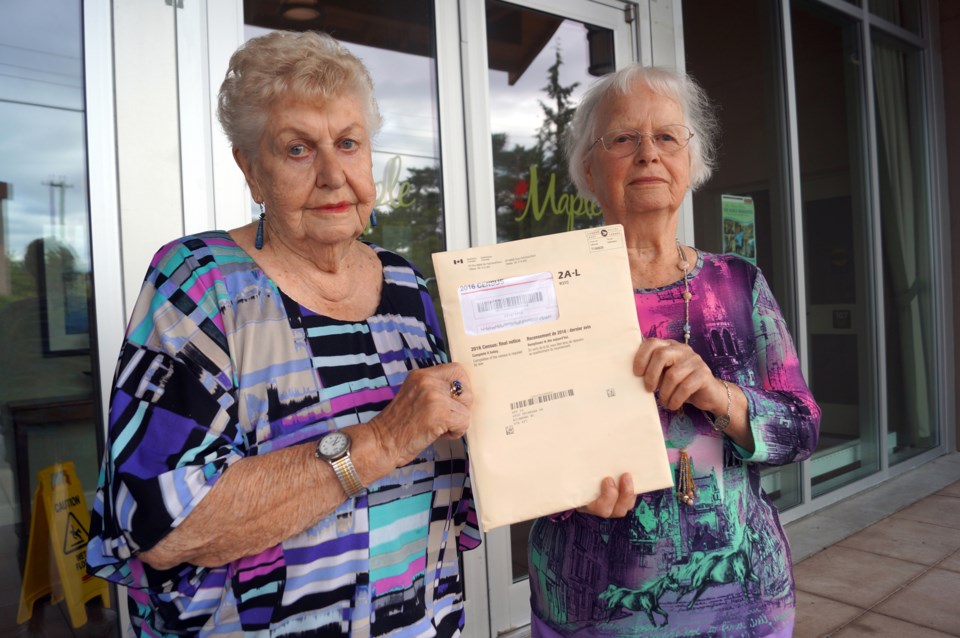Still sharp as a tack at age 93, Nadine Jones, a retired journalist, said she and many of her neighbours at The Maple Residences in Steveston were looking forward to completing the census form.
“I waited and waited, and so did 140 other people at ‘the Maples,’” said Jones.
But the forms never came. In fact, Statistics Canada bypassed sending individual forms to each resident altogether; instead, it employed a policy that asks managers or administrators of “collective dwellings,” to complete the forms for its residents.
Jones, who moved into what is described as an “independent living facility” in the summer of 2014, thinks the policy disenfranchises the elderly.
“It’s a Canadian right to have a ballot and census form,” said Jones.
“The point is a whole bunch of seniors are written off,” she added.
Neighbour Eileen Evans expressed similar concerns.
“It feels like they’re ignoring older people, like they don’t matter. We aren’t noticed,” said Evans.
Jones and Evans’ concerns, at the least, shed light on how data on seniors is collected and whether the methodology is fair.
Jones asked the front desk for the census form last month but was told it had already been filled out by administrators.
Maple Residences assistant manager Wendy McDonough confirmed that, at the request of Statistics Canada, she provided the relevant information (including marital status, sex, age and languages spoken) of the residents, via a spreadsheet.
“I guess they know my marital status,” quipped Jones, who, ironically, is also a former census commissioner.
McDonough said managers were transparent about the process for anyone who asked about the census form. She said about five residents, including Jones, raised questions.
Jones estimates about half of the residents (there are about 160, total, according to McDonough) wanted to fill out their own forms. She said about one quarter of the residents have cognitive problems, while McDonough estimates about 40 per cent do.
“It really isn’t much information, but the point is everyone should have had the form and they didn’t. And I didn’t have this (process) explained it to me,” said Jones.
“It’s my right as a Canadian,” she said.
Statistics Canada told the Richmond News that information on residents of collective dwellings is collected in bulk form.
“To reduce the burden on Canadians and manage collection costs, Statistics Canada works with staff at hospitals, retirement homes, shelters, etc. to collect as much information as possible from the administrative records of institutions and residences. The information in these records is accurate and reliable,” stated Statistics Canada spokesperson Nadine Lacroix, via email.
Notably, there are institutional (jails, hospitals) and non-institutional collective dwellings (seniors’ residences, work camps, military bases). Both are only given the short-form census, which is expected to be filled out, in bulk, by the dwelling’s administrator.
“Many of the questions on the long-form do not apply to this population,” explained Lacroix.
However, Maple Residences manager Rob Pretli said there isn’t much difference between his place and an apartment building, and it is certainly not a nursing home — if a resident needs extra support, it is provided through Vancouver Coastal Health, family or other outside services, noted Pretli.
The census — used to create a demographic snapshot of populations for economic and social planning — is “meant to provide a portrait of the non-institutionalized population of Canada,” noted Lacroix.
Statistics Canada’s website states people living in seniors’ residences are defined as non-institutionalized residents. So, if people such as Jones are “non-institutional,” then why are they not afforded the right to fill out their own census, let alone be included in the long-form census?
“I personally think everyone should have had (the census) sent to their (mail) box . . . I guess it depends on how Statistics Canada has us registered,” said Pretli.
When Steveston-Richmond East MP Joe Peschisolido was contacted about Jones’ concerns he said, at first glance, it does not seem right that citizens living in a seniors’ residence do not directly receive a census form.
“It does not sound right,” said Peschisolido, who added he has since contacted the Minister of Innovation, Science and Technology for clarification on the policy.
“Residents should have access to the census . . . We can’t change what’s done, but we can make sure it doesn’t happen again,” he said.
“The least that can occur now is for Statistics Canada to provide access to the information,” upon request, noted Peschisolido.
For its part, Statistics Canada has acknowledged some difficulties in collecting data on seniors’ residences.
“In some seniors’ residence collective dwellings, difficulties in collection and data processing resulted in the occupants being classified as living alone in their unit regardless of their true living arrangements,” notes StatCan.gc.ca.
In 2011 there were 2,910 collective dwellings classified as seniors’ residences, housing a total of 135,240 people. Of those, 96,415 were female.



